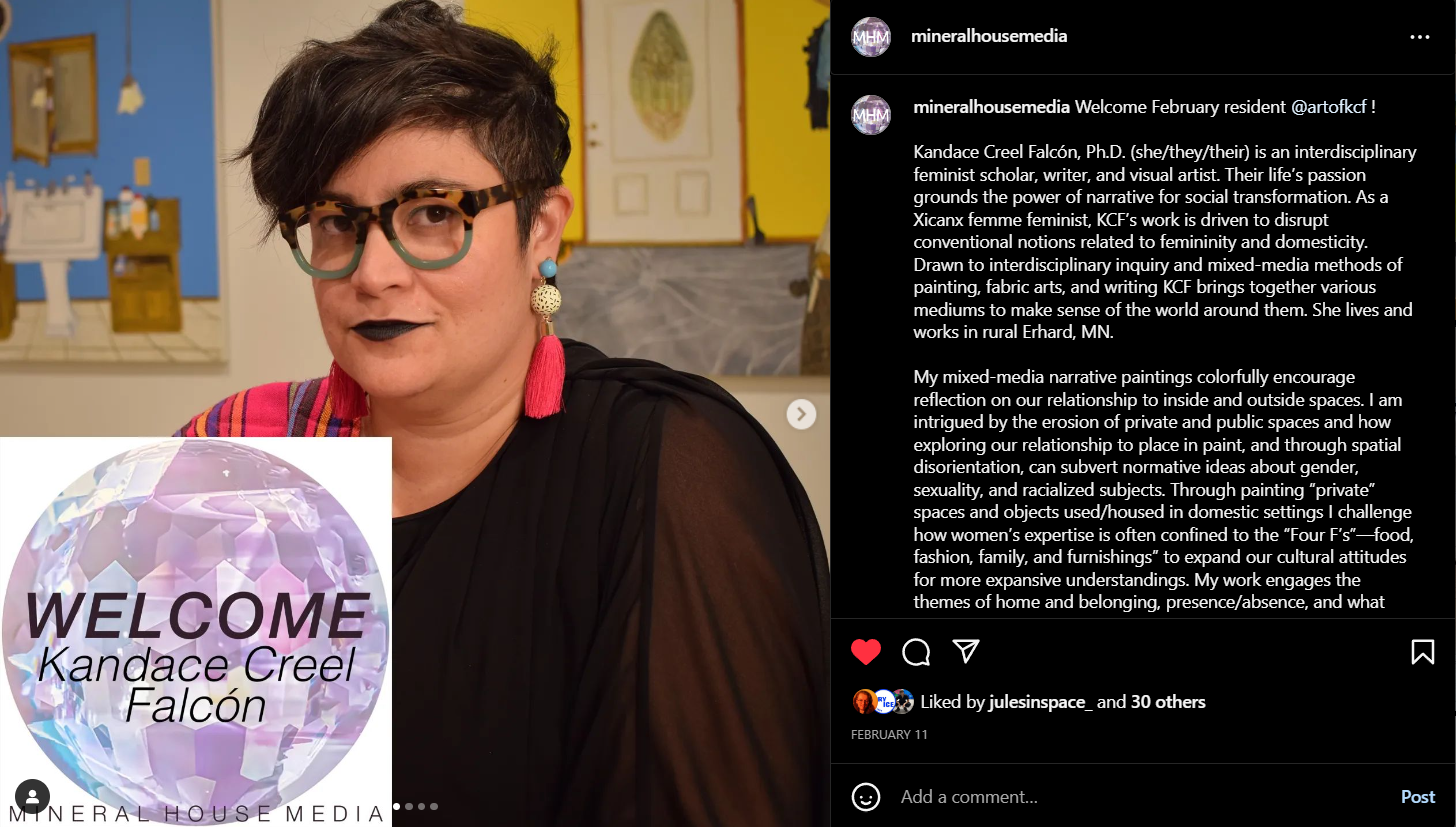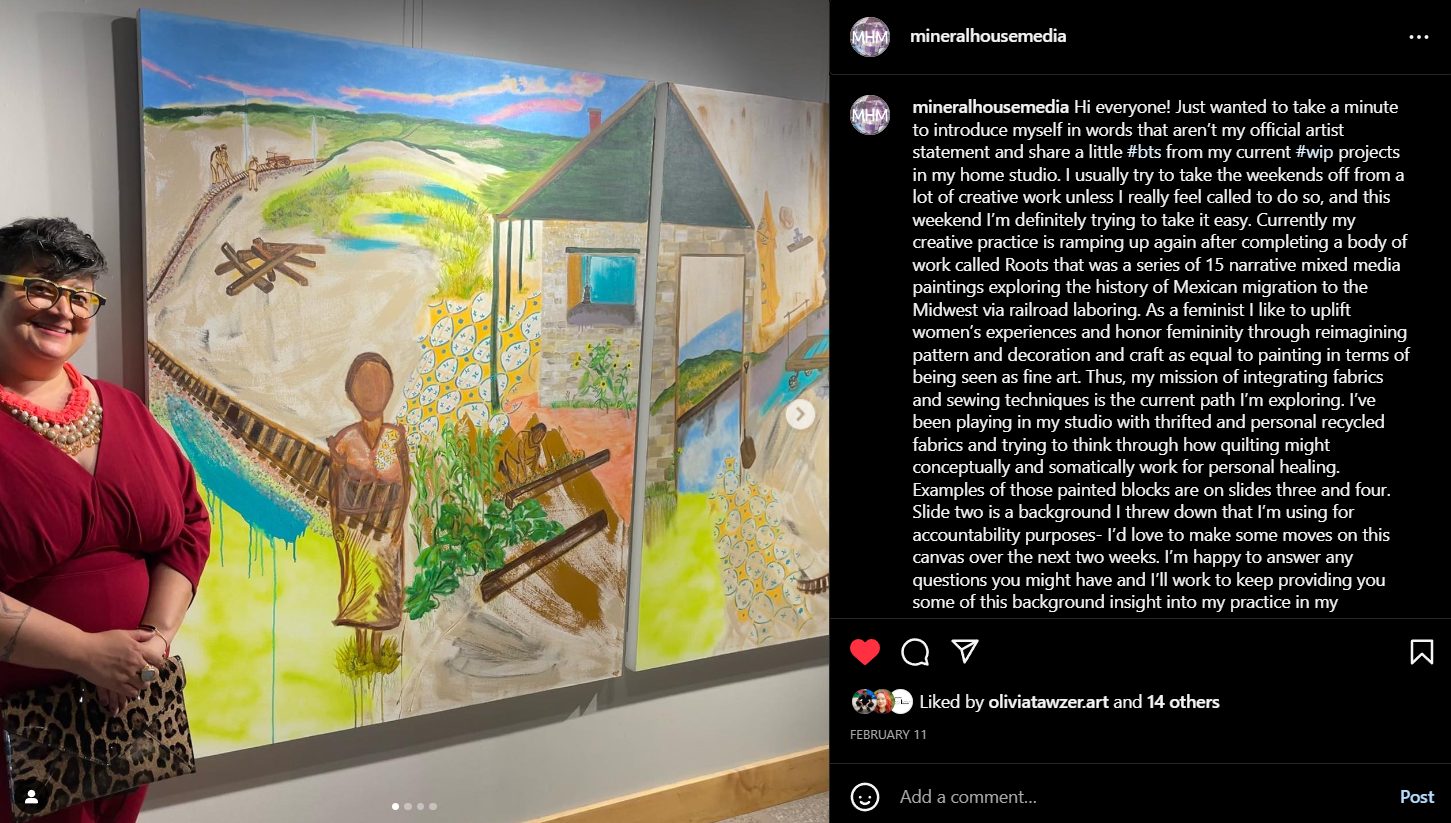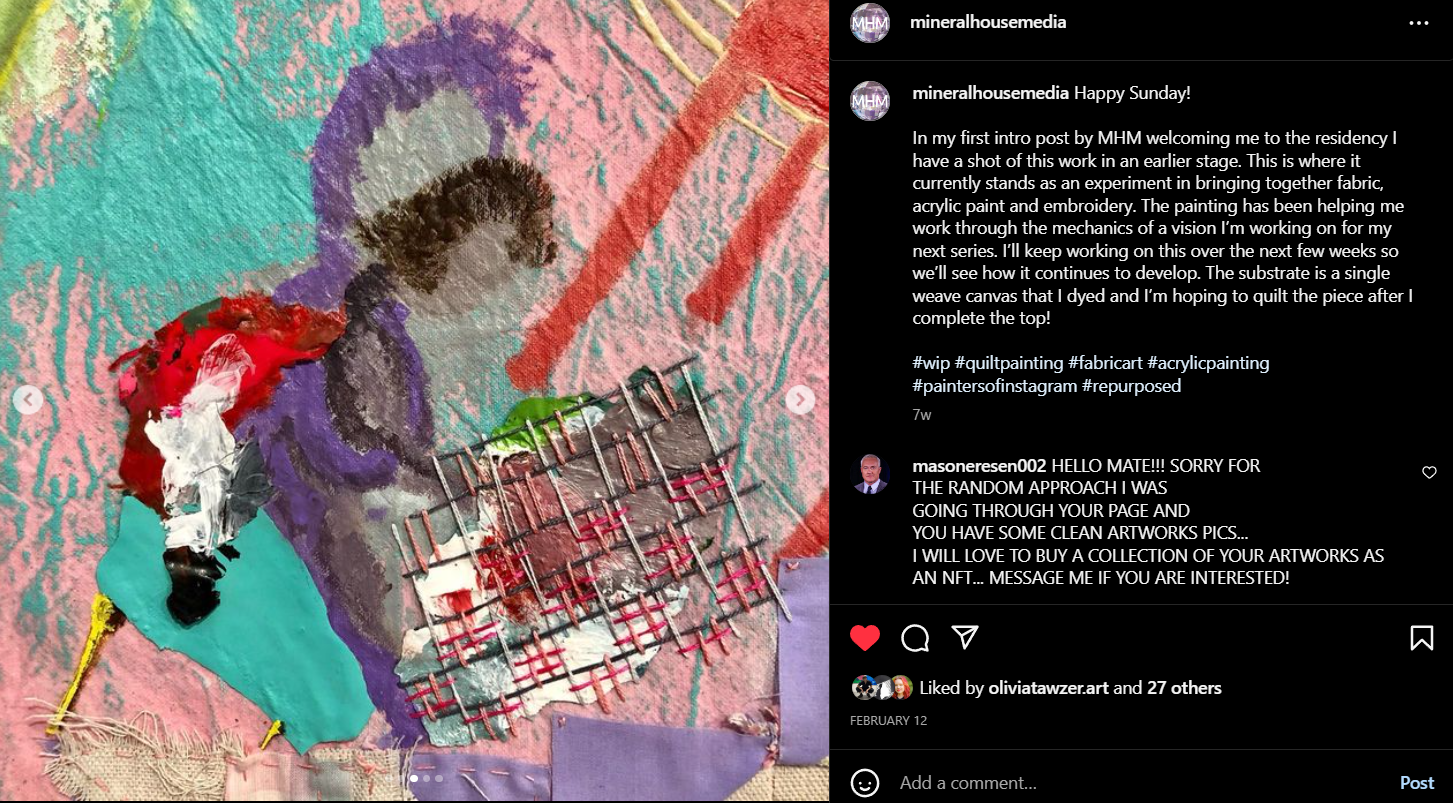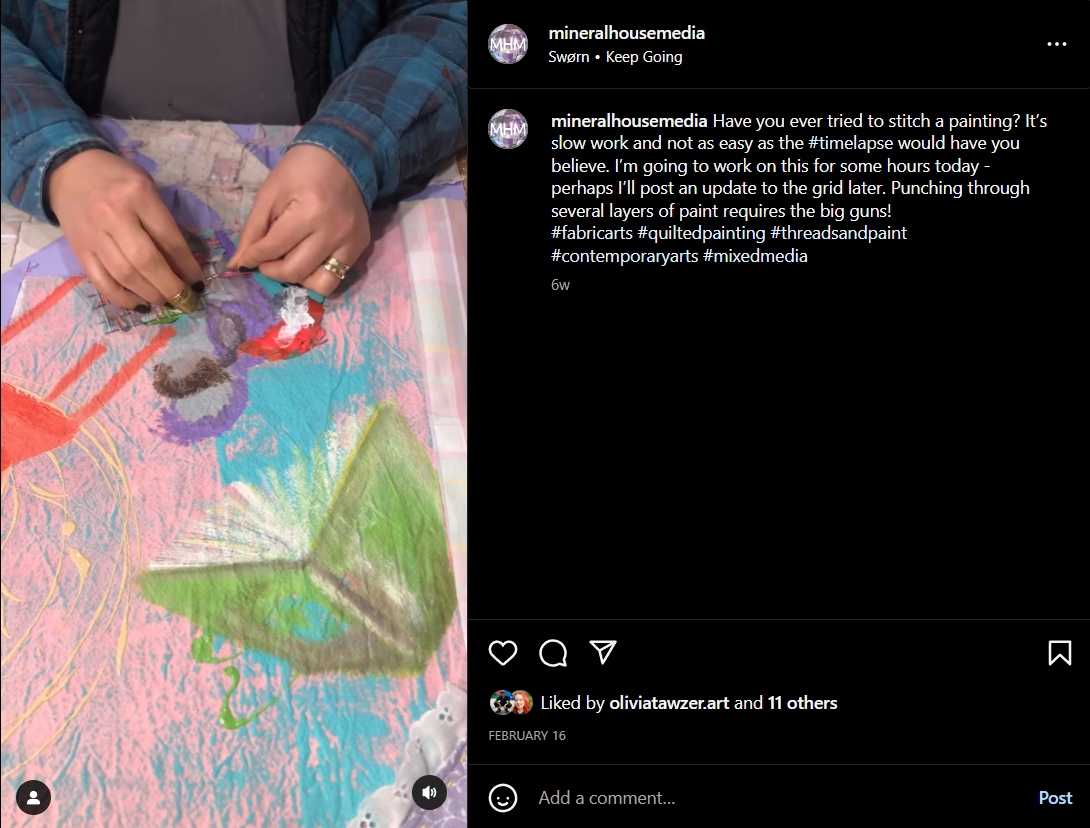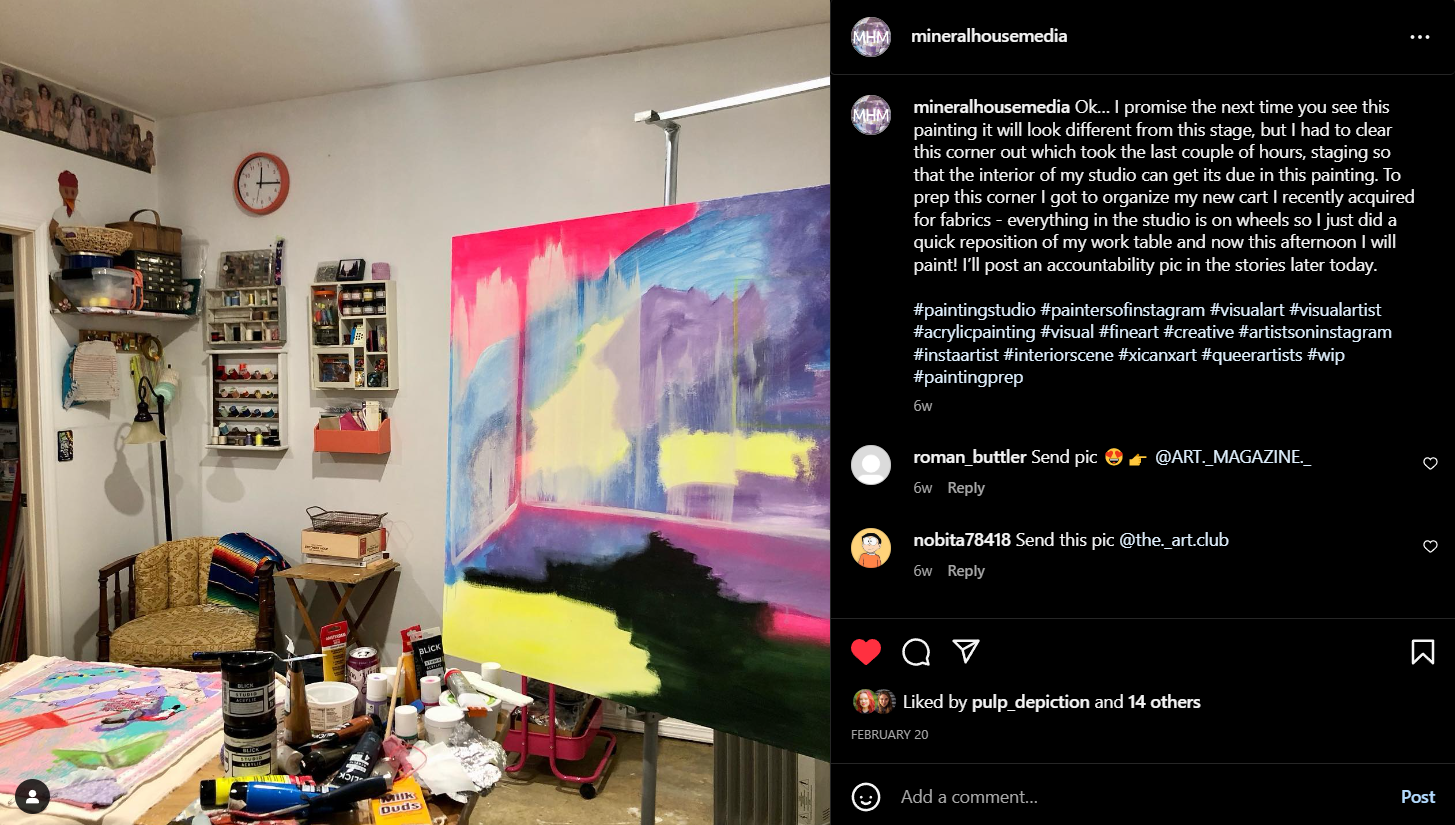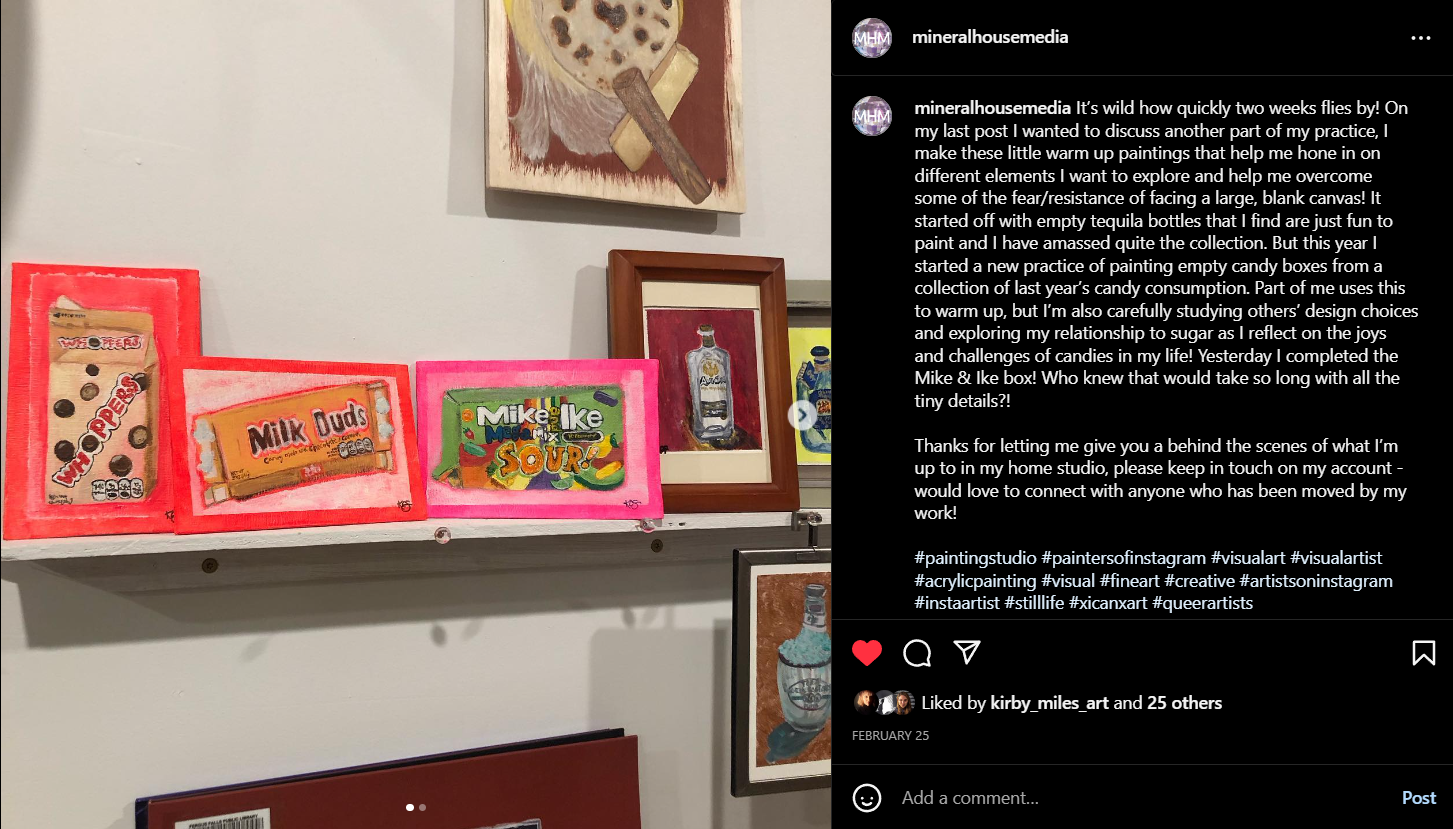Interview with Kandace Creel Falcón, Ph.D.
Interview with Kandace Creel Falcón, Ph.D.
February 2023 Digital Resident
A conversation with Clay and Olivia of Mineral House Media
MHM: You are a Xicanx scholar, writer, feminist, and visual artist, all with a Ph.D! Tell us more about your background and your path to pursue these professions.
KCF: I am so grateful for the path I’ve been on as someone who has had maybe a different route to artistic creation than most. As an undergraduate student in the early 2000s my parents really pressured me to pursue an academic trajectory that would result in a job. As they were helping to pay for my college education I was willing to appease them by majoring in Psychology because that was a career path they understood and supported. My true love at the time however, was what I was learning in my Women’s Studies classes. So, what started out as a minor turned into a double major and as college was coming to an end I saw a job path through academia which is what inspired me to apply for Master’s and Doctoral Programs in Women’s and Gender Studies. I was accepted into the Ph.D. Program in Feminist Studies in 2004 at the University of Minnesota and so I moved to Minneapolis to pursue my dream at that time. While in graduate school I found the experience to be particularly grueling. I was searching for creative outlets to try to manage the difficulty of academic disciplining that happens when working on a Ph.D. I joined a women of color writing group that was transformative; it helped connect me back to my voice. And around the same time my really good friend, who was also deep in the thralls of dissertation writing, and I used to take one day every other week or so to have “Chicana craft day.” We would take off an entire day from writing and not focus on our academic work instead, we would make little creative artistic projects, a lot of folk art inspired home decor projects were made while we listened to music, laughed, created and ate pan dulce. I found this experience really healing and it helped me reconnect with my creativity in a way that I didn’t realize I needed.
After graduate school I was offered a professor job at a regional university in northwest Minnesota. It was rewarding work with the students, yet also very draining due to administrative circumstances. When I earned tenure and was granted a sabbatical I was ready to try to figure out how to better manage my health in what felt like a super toxic environment for me. While on sabbatical I took a Foundations of 3-D Art class at the local community college on a complete whim and fell in love with the process of imagining something in my mind and making it come to life in the material realm. I went back to teaching one year after that transformational experience while also continuing to pursue studies in fine arts. In the spring of 2019 I took my first painting class and have been painting ever since! I loved everything about the process and became obsessed. My obsession allowed me to let go of my passion that was once dedicated to academia. Now in my fourth year of painting seriously I am recognizing that I still call on a lot of the skills I honed in academia - whether that is the deep research based approach I take on my series works, or through the continued writing and reflecting I offer to readers of my twice monthly newsletter project [www.tinyletter.com/ArtofKCF]. I’m grateful for the ways my scholarly self informs my painting and other creative processes!
MHM: What does a typical studio day look like for you?
KCF: A typical and ideal studio day starts with reading in bed, a quick trip to my yoga mat and sharing breakfast with my wife. Then I head downstairs to my studio sometime between 8-10am where I try to take stock of what I’d like to spend my time doing. I journal, plan, and do some random warm-up mark making in my sketchbook. Then I usually set up for the projects I want to get into that day before heading back upstairs for lunch. I will come back down to the studio and paint for as long as I can. I try to aim for four hours of painting per day but rarely hit that. I am wondering if I should adjust that to the 1-2 hours which is what I usually end up accomplishing. Now that I’m doing a lot of mixed-media sewing work that gets integrated into the paintings I will do some of that handwork when I’m needing a break from painting. I like making forward movement and switching things up keeps me excited to come back to what I’ve left behind. I both enjoy and also loathe having too many projects going at once, but I am never bored.
MHM: Reflection through writing is an integral part of your studio practice. What is the back-and-forth of writing and tangible making like for you?
KCF: This might seem counterintuitive, but I find my writing and painting to be part of the same act of creation for me. In other words, I see both as an extension of each other - when I’m painting I’m writing and when I’m writing I’m painting. I spend a lot of time trying to integrate the logics of painting into my writing as well as using the process of writing to inspire my narrative paintings. In this way I can relieve myself of the guilt I used to feel when I was writing or painting and not doing the other one. I also use my writing practice to help me make conceptual sense of my paintings. This give and take between writing and tangible making becomes a really beautiful co-collaborative opportunity for me, and I really thrive under the opportunity to think deeply about the work I am making.
Kitchen Saints
MHM: Tell us about your Kitchen Saints series. How do you approach your different bodies of work in your practice?
KCF: I tend to think and make in series because I do like to exhaust myself in terms of the versions and variations that are possible when working through the form of how my paintings might relate to each other. I like the challenge of tying works together by a common theme. To relate to the previous question I liken my paintings like chapters in a book - they make a whole body of work but each tell a part of the story. In the Kitchen Saints series I was really excited to play with oils on wood from the perspective of retablo making. I love the lush feel and gloss of oil though I tend to paint my larger works in acrylic and latex. With the Kitchen Saints I appreciated the opportunity to merge my background as someone raised Catholic, with my love of Mexican food, with the history of retablo making. My series work starts from the conceptual framework which I build on with scholarly research that informs the process of painting. During the painting process I then also remain open to what emerges that can then re-inform my conceptual frame. I try to lean into the emotional, affective, and mystical aspects of painting to see what can then be added back into how I describe the work.
MHM: For those unfamiliar with the concept, could you elaborate on the “Four F’s” concept, and the role it has played in your own life and work?
KCF: Feminist media scholars have long been critical of the ways that women have historically been relegated as experts only in the “four f’s” of journalism - food, family, fashion, and furnishings. As someone deeply interested in femininity as a major undercurrent of my work, particularly around the ways it is often undervalued, minimized, and misunderstood, I really like this framework as something to explore. For me, I recognize the ways that this construct both needs to be challenged - because of course women can be experts in any subject matter - and played with to also disrupt ideas about femininity. I’m so passionate about that point that I became a Women’s Media Center She Source expert. And I’m equally invested in seeing if there is a way one might challenge the limits of expertise around the “four f’s” by playing with the concept from a painter’s point of view. The Four F’s from the history of painting would have largely been relegated to lower positions in painting subject hierarchies like still life and genre paintings - precisely because they relate to what has historically been women’s realm of the domestic sphere in Western societies. I like the challenge of seeing if there are ways to bring the interior painting into conversation with a history painting for instance, and what that might look like from the view of our twenty-first century perspectives.
Old Gaucho Trail
MHM: When did you decide to take the research journey into feminist theory and histories of domestic life? What did starting that journey look like?
KCF: I have always been interested in the concepts of home and belonging as a Chicanx person who was born in Kansas but grew up in New Mexico. While living the first third of my life in Albuquerque, I felt like an outsider as someone with Kansas Mexican roots, and as someone with a white parent. However, when in Kansas I felt like I belonged but also since I didn’t live with my Mexican American family, and was from New Mexico, I felt apart from that geography as well. So, my PhD research really dug into this feeling, trying to make sense of how women make homes and belonging a reality in Midwestern spaces. I believe some of my work in this lifetime is to elevate the stories and impact of women and queer folk in our communities, and to challenge ideas that we don’t have the right to claim deep roots and belonging in places like Kansas or Minnesota.
MHM: How did you land in rural Minnesota, and how has living there shaped your thinking and making?
KCF: In 2016 my wife took a new job that covers five rural counties in west-central and north-central Minnesota that prompted our journey to look for a new home. We were looking for places that would help us split the commute to our respective jobs and we were open to living rurally. My wife grew up on a farm and loved rural places and I had always dreamed of having chickens and enjoying fresh eggs. Our home in a small city wouldn’t allow for backyard chickens so I was ready to leave! When we found our place on twenty acres kind of in the middle of nowhere we had an instant connection. We’ve now been here since 2017 and every season has brought new joys. I am in love with the forced slow down of living rurally, by that I mean everything just takes more time and planning - from getting groceries to plowing our nearly a mile-long driveway. I’ve found that living rurally has allowed me to reconnect with nature in a way I was truly missing from my urban and smaller city life. That deeper relationship with nature shows up as subject matter for me in different ways, especially in my Roots series where the prairie plays an important character in the paintings. I’m fascinated by the birds that visit our place and am currently researching their migration paths. And I like incorporating critters into my paintings, from goats, to chickens, to mice and bats, it helps me feel like while we are very isolated out here, we are definitely not alone.
MHM: While exploring serious subject matter, your work feels playful and exploratory. Is play something you prioritize in your practice?
KCF: I love that the work feels playful to the viewer. I would attribute that sense of whimsy to my queer sensibilities I aim to infuse into the work. I like to have a weird perspective, and bright garish colors that feel like a more accurate version of what I see in front of me or through my imaginary realm. Also, as someone who came to making art later in life I am always trying to lean into the pleasure and joy available to me getting to do work that feels luxurious. It is a true privilege to get to make art and be creative as my means of contributing to the world, I want to give myself and others permission to be delighted and have wonder about this awesome life we get to explore, even through personal or collective challenges; I definitely try to prioritize these practices in my work even in exploring difficult subject matters.
Dreaming New Archives in the Guest Room
MHM: You mention dreams and dreamlike qualities as guiding forces in your work. Are these literal dreams, or dreams in the sense of ambitions? How does dreaming, in either sense, influence your work?
KCF: It’s both! I am a religious dream journaler. I have always had super vivid dreams while sleeping and I often remember my dreams upon waking. I have a notebook where I capture the narrative threads of the dreams as I remember them and I will also sketch weird images or feelings that come directly from my dreaming self. I love the possibility of working these elements into paintings and writing as little unexpected elements. The other way dreaming functions in my work is through my queer utopia aspirations, I want to dream the world I want us to be living, one in which freedom and joy proliferates and suffering is diminished. In 2020 I titled the last painting I made for my Interior Intimacy series, “Dreaming New Archives in the Guest Room” which is a scene of a guest bedroom in our home that we lovingly refer to as the Gloria Anzaldúa Suite. In creating an archival space within a bedroom I was dreaming up ways to account for all that gets left out of a traditional archive, and attempting to inspire others to think about the many ways we might get even more creative about archival practices.
MHM: How do you know when a piece is finished? What does the life of a finished piece look like?
KCF: Such a great question! I am often in an intuitive give and take with a painting as I am making and often say when the painting says it’s done, then the painting is done. It’s interesting because sometimes I will have elements I think will be going into the painting that don’t end up making it onto the plane. But, those elements might show up in a different painting then. I think this is because I am so tied to the series approach in making, that the bigger question is more about when I think I’m done with the series. I will often have a goal in mind for the number of paintings I think it will take to explore, with an openness to change it if necessary as the work begins to emerge. At this point in my painting practice I do try to honor the finished painting, it serves as a time capsule of where I was in the moment of creation and revisiting it from this point in the timeline doesn’t seem fair to the painting. I rarely (if ever) go back in and rework something after the painting has indicated it’s finished. After the painting leaves my studio and is seen by others I love how it will often have new things to teach me when I’m out of the applying paint stage. It is so fun to see a finished work get to have a life beyond the studio and get to make new meanings outside of my interpretation.
MHM: If you could have any super power, what would you choose?
KCF: Definitely teleportation. The ability to simply be somewhere else and not have to go through the hours of travel by car or plane really appeals to me! Since time is such a valuable resource I would love to cut out the time it takes to get somewhere, and this super power could help me be in several places at once!
MHM: What is your favorite book or author? What artists influence you?
KCF: I could never hone in on just one favorite book or author. I read prolifically and widely. I’m drawn to poetry, memoir, academic texts, art history, and contemporary fiction in which I find deep wells of inspiration for my writing and painting practices. Some favorites of late include Brown Neon by Raquel Gutiérrez and Undrowned by Alexis Pauline Gumbs. As for artists who influence me, Patssi Valdez, Carmen Lomas Garza, and Amalia Mesa-Baines come to mind. I’m inspired by the life and work of the scholar/writer turned visual artist Nell Painter. And Bay Area artist, Cate White’s narrative paintings and her approach to painting definitely influence me in terms of how I want to marry abstraction and figuration in my current era of painting.
As a Xicanx femme feminist, KCF’s work is driven to disrupt conventional notions related to femininity. Their academic pursuits have sought to better understand power through their interest in popular culture, the written word, and the circulation of images. While at the University of Kansas pursuing two B.A. degrees in Women’s Studies and Psychology with a minor in Leadership, visual media became the subject of their cultural studies honors thesis (2004). This research led to their pursuit of a Ph.D. in Feminist Studies from the University of Minnesota (2010) where she infused media analysis alongside their interdisciplinary oral history and narrative research. For fourteen years they taught interdisciplinary methods of feminist inquiry in higher education institutions where they earned tenure and directed a Women’s and Gender Studies program at a regional university.
As a digital storyteller, fatigued by words in 2018 as she drafted a book manuscript, KCF spontaneously enrolled in a visual arts class at the local community college. Through pursing an Associates of Fine Arts Degree (2020) KCF shifted from analyzing the meaning of visual art, popular culture mediums, and narrative formations toward making. Drawn to mixed-media methods of painting, fabric arts, and writing KCF brings together various mediums to make sense of the world around them. She lives and works in rural Erhard, MN.
